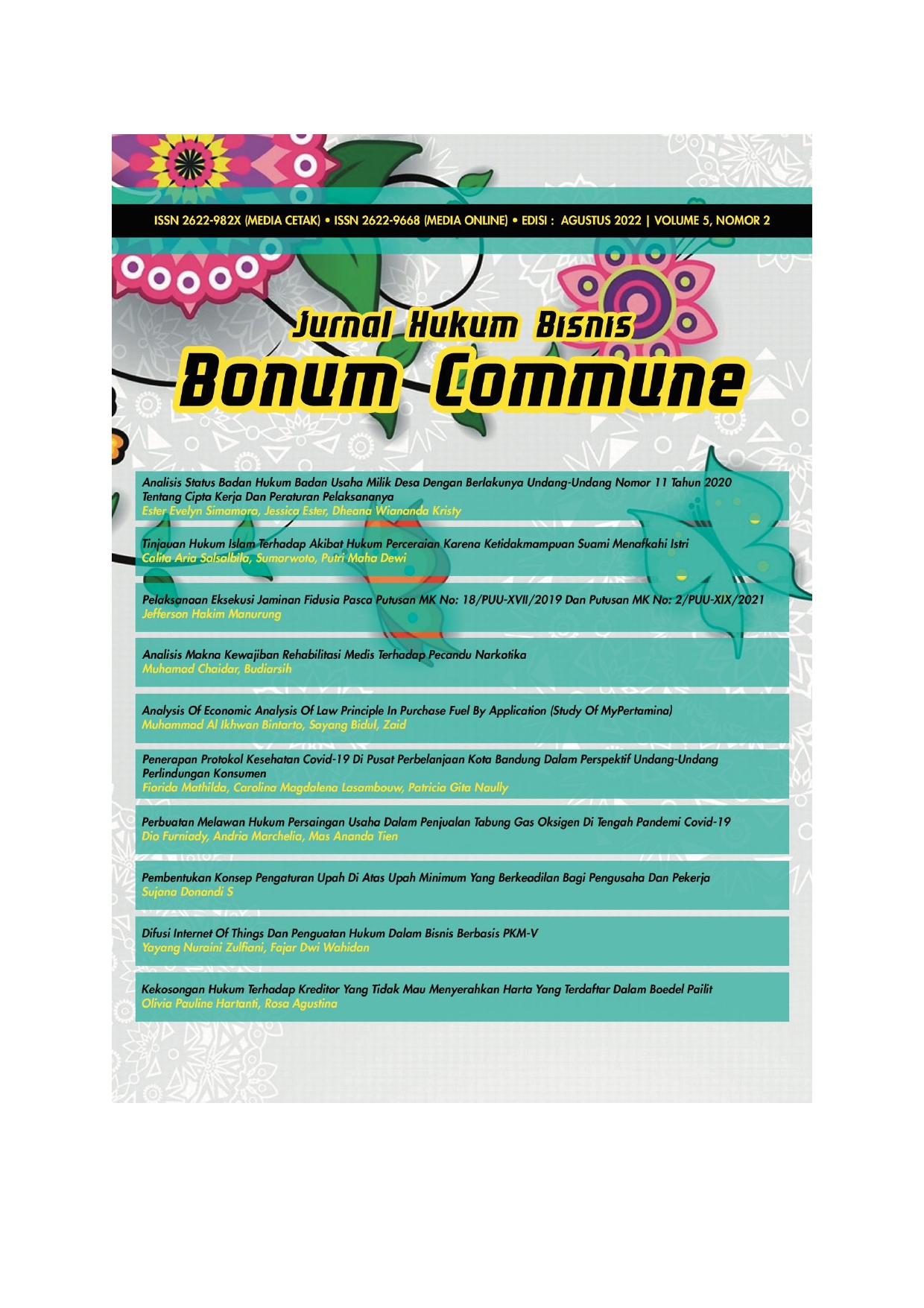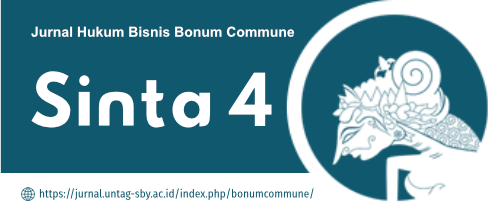PENGELOLAAN KEKAYAAN HAYATI DI KAWASAN “THE AREA” MENURUT UNCLOS 1982 [STUDI TENTANG NODUL POLIMETALIK (POLYMETALLIC NODULES)]
Abstract
Beautiful and challenging seabed charms and rapid developments in technology for deep sea exploration and exploitation have occurred during the negotiations of the United Nations Convention on the Law of the Sea 1982. The development of this technology can give us broader knowledge about wealth in the deep sea floor. Significantly known deposits on the seabed outside national jurisdiction and named the Area or "The Area" by UNCLOS, including phosphorus, aggregates, scale, sulfides, hydrates, oil, natural gas and many other substances undiscovered. In fact, due to changes in international market conditions and technical difficulties arising from the exploitation of polymetallic nodules, it is unlikely that these or other mineral resources will be commercially developed over the years. Other genetic resources related to certain marine minerals, which were discovered when UNCLOS was being negotiated, have generated great scientific and economic interest and could be the first resources of the Region to be exploited. UNCLOS has provided regulations and procedures to ensure effective protection of the protection and conservation of natural resources in the Area and prevention of damage to flora and fauna from harmful effects that may arise from activities in the Area. Also about how to cope better, scientifically, including the application of prevention criteria, threats and risks to vulnerable and threatened marine ecosystems and biodiversity in areas outside national jurisdiction. So this has led to the exploration of various potential approaches to their protection and management, using agreements and other relevant instruments based on general international law arrangements, particularly with UNCLOS 1982.
Pesona dasar laut yang indah dan menantang serta perkembangan yang pesat dalam teknologi untuk eksplorasi dan eksploitasi laut dalam sudah terjadi selama perundingan Konvensi PBB tentang Hukum Laut atau UNCLOS (United Nations Convention on the Law of the Sea) 1982. Atas perkembangan teknologi ini dapat memberi kita pengetahuan yang lebih luas lagi tentang kekayaan di dasar laut dalam. Endapan yang diketahui secara signifikan di dasar laut yang berada di luar yurisdiksi nasional dan di namai dengan Kawasan atau “The Area” oleh UNCLOS, termasuk fosfor, agregat, kerak, sulfida, hidrat, minyak, gas bumi dan masih banyak lagi zat-zat lainnya yang belum ditemukan. Sebenarnya, karena perubahan kondisi pasar internasional dan kesulitan teknis yang timbul sehubungan dengan eksploitasi nodul polimetalik, kecil kemungkinan sumber daya mineral ini atau lainnya akan dikembangkan secara komersial selama bertahun-tahun. Sumber daya genetik lainnya yang terkait dengan mineral laut tertentu, yang ditemukan ketika UNCLOS sedang dirundingkan, telah menimbulkan minat ilmiah dan ekonomi yang besar dan dapat menjadi sumber daya pertama dari Kawasan yang akan dieksploitasi. UNCLOS sudah memberikan peraturan dan prosedur untuk memastikan perlindungan yang efektif terhadap perlindungan dan konservasi sumber daya alam di Kawasan dan pencegahan terhadap kerusakan flora dan fauna dari efek berbahaya yang mungkin timbul dari kegiatan di Kawasan tersebut. Juga tentang bagaimana mengatasi secara lebih baik, secara ilmiah, termasuk penerapan kriteria pencegahan, ancaman dan risiko terhadap ekosistem laut yang rentan dan terancam serta keanekaragaman hayati di daerah di luar yurisdiksi nasional. Maka hal ini mendorong eksplorasi berbagai pendekatan-pendekatan yang potensial untuk perlindungan dan pengelolaannya, menggunakan perjanjian dan instrumen lain yang relevan berdasarkan pengaturan hukum internasional umum, khususnya dengan UNCLOS 1982.
Downloads
References
Dahuri, Rokhmin, ‘Pradigma Baru Pembangunan Indonesia Berbasis Kelautan’, Wradigma Baru Pembangunan Indonesia Bebasis Kelautan, 2003
Djunarsjah, Eka. Survey Hidrogafi Untuk Penetapan Batas Landas Kontinen (Hydrographic Survey For The Limitation Of The Continental Shelf), Bandung: UNPAD Journal of International Law, 2004
http://geomagz.geologi.esdm.go.id/nodul-polimetalik-perburuan-masa-depan-di-dasar-laut/ diakses pada 30 November 2019.
https://mimirbook.com/id/8a1ad83245a diakses pada 30 November 2019.
https://www.hukumonline.com/berita/baca/lt5bfd03d13ceb3/mengurai-persoalan-hukum-pengelolaan-tambang-bawah-laut/diakses pada 30 November 2019.
https://prezi.com/3ukftrp5qfv2/area-dasar-laut-internasional/ diakses pada 30 November 2019.
https://en.wikipedia.org/wiki/International_Seabed_Authority diakses pada 30 November 2019.
https://slideplayer.info/slide/4877696/diakses pada 30 November 2019.
https://kumparan.com/muhammad-taufan1530163979173/mungkinkah-indonesia-turut-serta-memanfaatkan-harta-karun-di-dasar-laut-internasional-27431110790542942 diakses pada 30 November 2019.
https://blog.ub.ac.id/davidfatkhurrohman/2012/01/14/hydrothermal-vents/diakses pada 30 November 2019.
ISA, International Seabed Authority, ‘International Seabed Authority: Basic Texts’, ISBA/19/C/5, 2013
JG, Starke. 2008. Pengantar Hukum Internasional, terjemahan dari Introduction to International Law.. Sinar Grafika. Jakarta.
Jaeckel, Aline, Kristina M. Gjerde, and Jeff A. Ardron, ‘Conserving the Common Heritage of Humankind – Options for the Deep-Seabed Mining Regime’, Marine Policy, 2017 <https://doi.org/10.1016/j.marpol.2017.01.019>
Karl, D. M., C. O. Wirsen, and H. W. Jannasch, ‘Deep-Sea Primary Production at the Galapagos Hydrothermal Vents’, Science, 1980 <https://doi.org/10.1126/science.207.4437.1345>
Koers, W Albert. Konvensi Perserikatan Bangsa Bangsa Tentang Hukum Laut (Yogyakarta: Gajah Mada University Press, 1994)
Kuhn, Thomas, Anna V. Wegorzewski, Carsten Rühlemann, and Annemiek Vink, ‘Composition, Formation, and Occurrence of Polymetallic Nodules’, in Deep-Sea Mining: Resource Potential, Technical and Environmental Considerations, 2017 <https://doi.org/10.1007/978-3-319-52557-0_2>
Kusumaatmadja, Mochtar, ‘Hukum Laut Internasional’, Jurnal Hukum Laut, 1983
Lodge, Michael W., ‘International Seabed Authority’, International Journal of Marine and Coastal Law, 2011 <https://doi.org/10.1163/157180811X576929>
———, ‘The Common Heritage of Mankind’, International Journal of Marine and Coastal Law, 2012 <https://doi.org/10.1163/15718085-12341248>
Tomy Michael, ‘Memaknai Frasa “ Dengan Rahmat Tuhan Yang Maha Esa ” Dalam Undang-Undang Republik Indonesia Nomor 12 Tahun 2011 Tentang Pembentukan Peraturan Perundang-Undangan’, 12, 2011, 1–10.
Wang, Xiaohong, and Werner E.G. Müller, ‘Marine Biominerals: Perspectives and Challenges for Polymetallic Nodules and Crusts’, Trends in Biotechnology, 2009 <https://doi.org/10.1016/j.tibtech.2009.03.004>
Windari, Retno. Hukum Laut, Zona-Zona Maritim sesuai UNCLOS 1982 dan Konvensi-Konvensi Bidang Maritim, Jakarta. Badan Koordinasi Keamanan Laut, 2009)
YouTube. (2013, Maret 27). Polumetallic Nodules [Berkas video]. Diperoleh dari https://www.youtube.com/watch?v=71J8Yqykgs0
YouTube. (2019, Oktober 9). International Seabed Authority [Berkas video].Diperoleh dari https://www.youtube.com/watch?v=tzP-WqTJR_w
YouTube. (2018, April 16). Introduction to the International Seabed Authority and Seabed mining part 1 [Berkas video]. Diperoleh dari https://www.youtube.com/watch?v=Tlumf1ivuPg
YouTube. (2019, Agustus 11). Concerns grow about seafloor mining [Berkas video]. Diperoleh dari https://www.youtube.com/watch?v=gQMgABp-k3c
YouTube. (2017, Juni 2017). Exploration of Deep Sea Minerals [Berkas video]. Diperoleh dari https://www.youtube.com/watch?v=rKYG-Arz9FA
Authors who publish with Jurnal Hukum Bisnis Bonum Commune agree to the following terms:
- Authors transfer the copyright and grant the journal right of first publication with the work simultaneously licensed under a Creative Commons Attribution-ShareAlike 4.0 International License.. that allows others to share the work with an acknowledgement of the work's authorship and initial publication in this journal.
- Authors are able to enter into separate, additional contractual arrangements for the non-exclusive distribution of the journal's published version of the work (e.g., post it to an institutional repository or publish it in a book), with an acknowledgement of its initial publication in this journal.
- Authors are permitted and encouraged to post their work online (e.g., in institutional repositories or on their website) prior to and during the submission process, as it can lead to productive exchanges, as well as earlier and greater citation of published work (See The Effect of Open Access)






